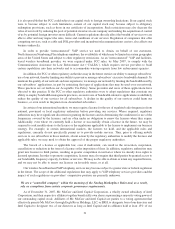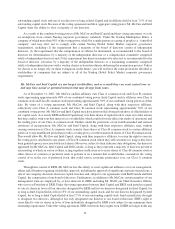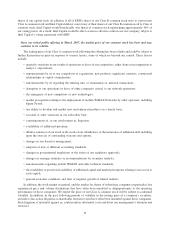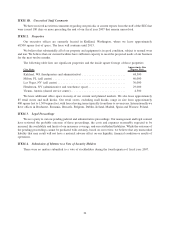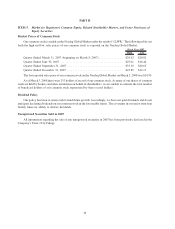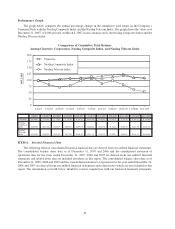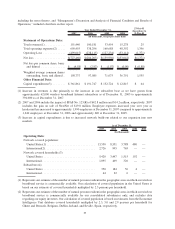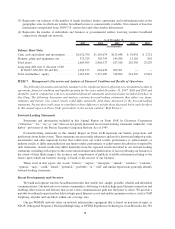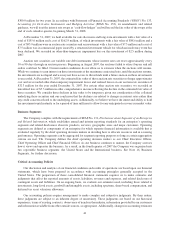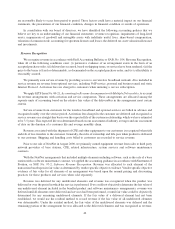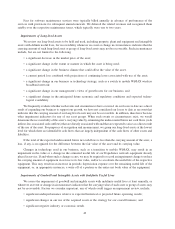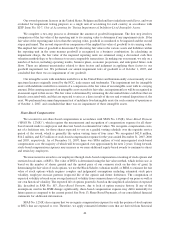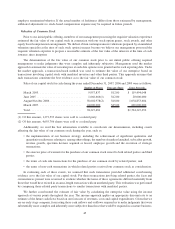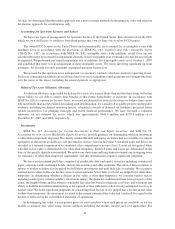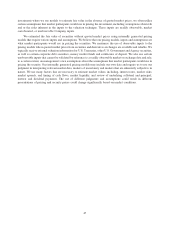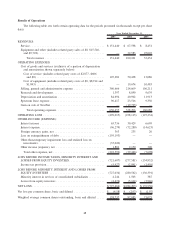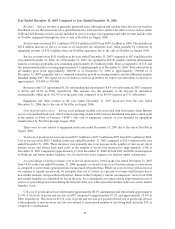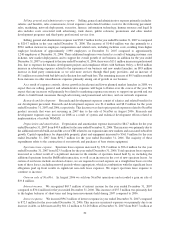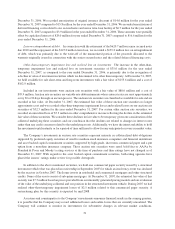Clearwire 2007 Annual Report Download - page 49
Download and view the complete annual report
Please find page 49 of the 2007 Clearwire annual report below. You can navigate through the pages in the report by either clicking on the pages listed below, or by using the keyword search tool below to find specific information within the annual report.$300.0 million for two years. In accordance with Statement of Financial Accounting Standards (“SFAS”) No. 133,
Accounting for Derivative Instruments and Hedging Activities (SFAS No. 133),its amendments and related
guidance, we will treat the interest rate swaps as “cash-flow hedges” and will record the fair value of the swaps at the
end of each calendar quarter, beginning March 31, 2008.
At December 31, 2007, we held available for sale short-term and long-term investments with a fair value of a
total of $155.6 million and a cost of $162.9 million, of which investments with a fair value of $88.6 million and a
cost of $95.9 million were in auction rate securities and an investment with a fair value of $7.5 million and a cost of
$7.5 million was in commercial paper issued by a structured investment vehicle for which an insolvency event has
been declared. We recorded an other-than-temporary impairment loss on this investment of $2.5 million during
2007.
Auction rate securities are variable rate debt instruments whose interest rates are reset approximately every
30 or 90 days through an auction process. Beginning in August 2007, the auctions failed to attract buyers and sell
orders could not be filled. Current market conditions do not allow us to estimate when the auctions will resume.
While we continue to earn interest on these investments at the maximum contractual rate, until the auctions resume,
the investments are not liquid and we may not have access to these funds until a future auction on these investments
is successful. At December 31, 2007, the estimated fair value of these auction rate securities no longer approximates
cost and we recorded other-than-temporary impairment losses and realized losses on our auction rate securities of
$32.3 million for the year ended December 31, 2007. For certain other auction rate securities, we recorded an
unrealized loss of $7.3 million in other comprehensive income reflecting the decline in the estimated fair value of
these securities. We consider these declines in fair value to be temporary given our consideration of the collateral
underlying these securities and our conclusion that the declines are related to changes in interest rates rather than
any credit concerns related to the underlying assets. Additionally, we believe we have the intent and ability to hold
the investments until maturity or for a period of time sufficient to allow for any anticipated recovery in market value.
Business Segments
The Company complies with the requirements of SFAS No. 131, Disclosures about Segments of an Enterprise
and Related Information, which establishes annual and interim reporting standards for an enterprise’s operating
segments and related disclosures about its products, services, geographic areas and major customers. Operating
segments are defined as components of an enterprise for which separate financial information is available that is
evaluated regularly by the chief operating decision makers in deciding how to allocate resources and in assessing
performance. Operating segments can be aggregated for segment reporting purposes so long as certain aggregation
criteria are met. The Company defines the chief operating decision makers as our Chief Executive Officer,
Chief Operating Officer and Chief Financial Officer. As our business continues to mature, the Company assesses
how it views and operates the business. As a result, in the fourth quarter of 2007 the Company was organized into
two reportable business segments: the United States and the International business. See Note 16, Business
Segments, for further discussion.
Critical Accounting Policies
Our discussion and analysis of our financial condition and results of operations are based upon our financial
statements, which have been prepared in accordance with accounting principles generally accepted in the
United States. The preparation of these consolidated financial statements requires us to make estimates and
judgments that affect the reported amounts of assets, liabilities, revenues and expenses, and related disclosure of
contingent assets and liabilities. On an ongoing basis, we evaluate our estimates used, including those related to
investments, long-lived assets, goodwill and intangible assets, including spectrum, share-based compensation, and
deferred tax asset valuation allowance.
Our accounting policies require management to make complex and subjective judgments. By their nature,
these judgments are subject to an inherent degree of uncertainty. These judgments are based on our historical
experience, terms of existing contracts, observance of trends in the industry, information provided by our customers
and information available from other outside sources, as appropriate. Additionally, changes in accounting estimates
41


